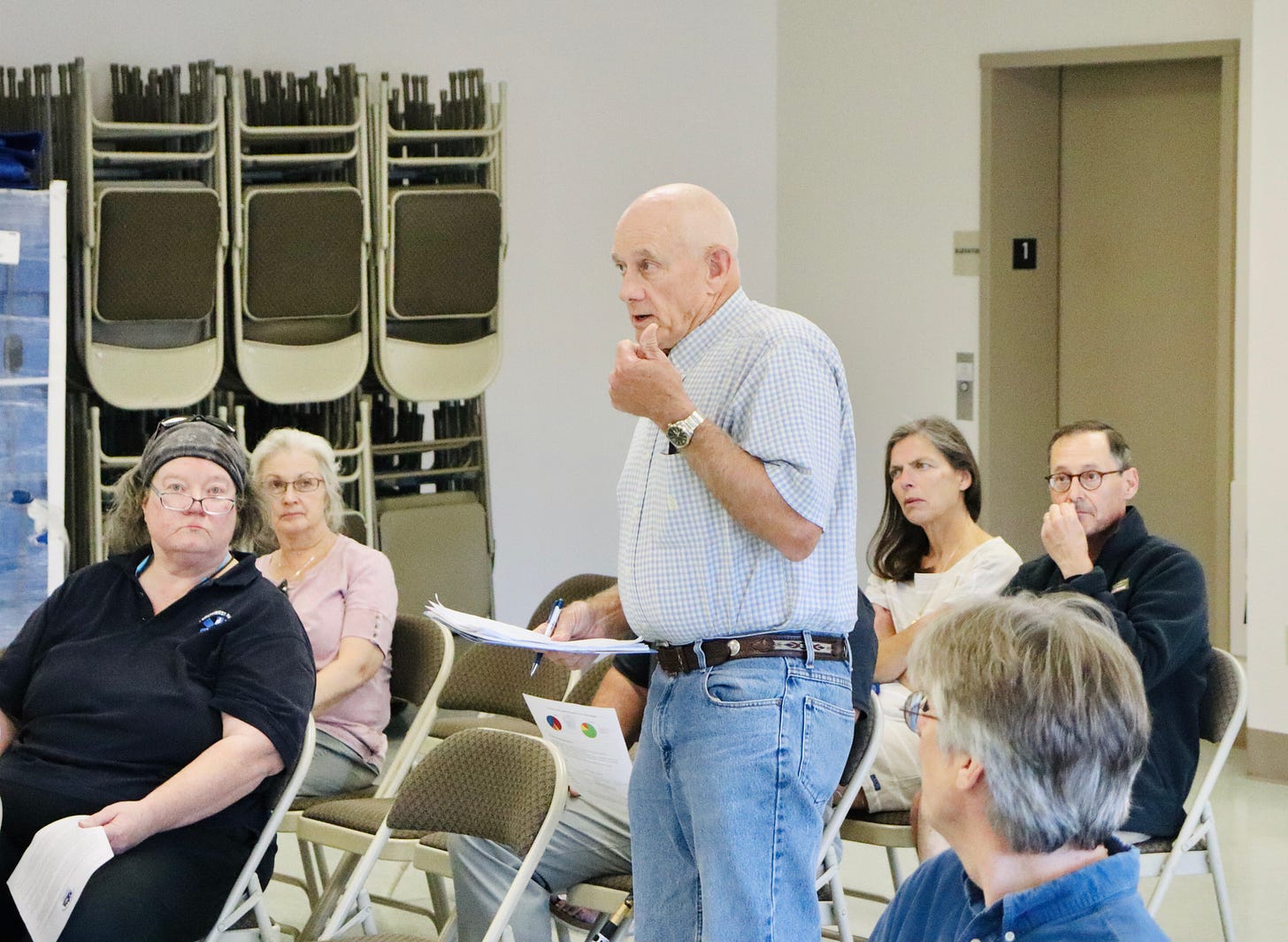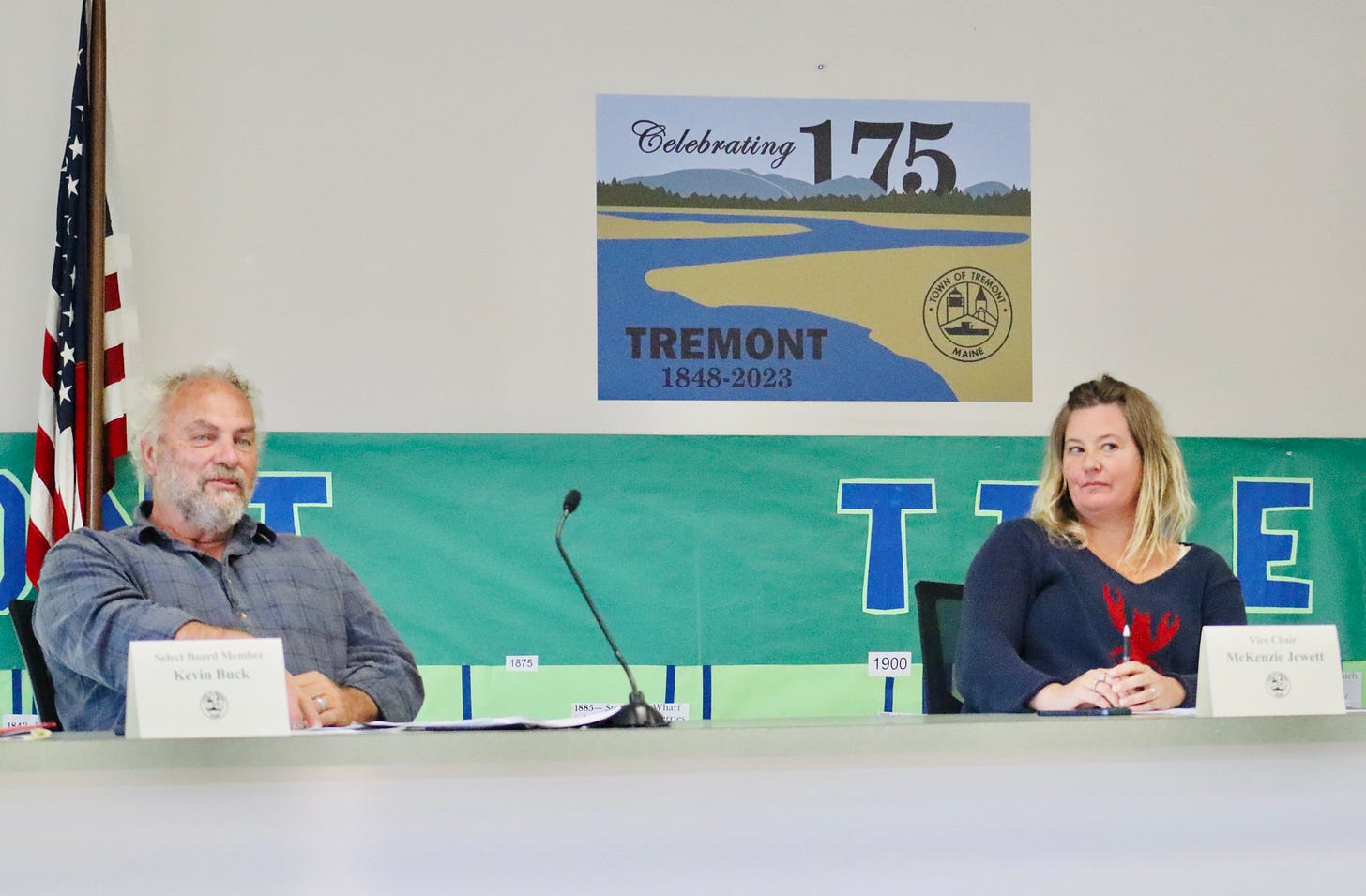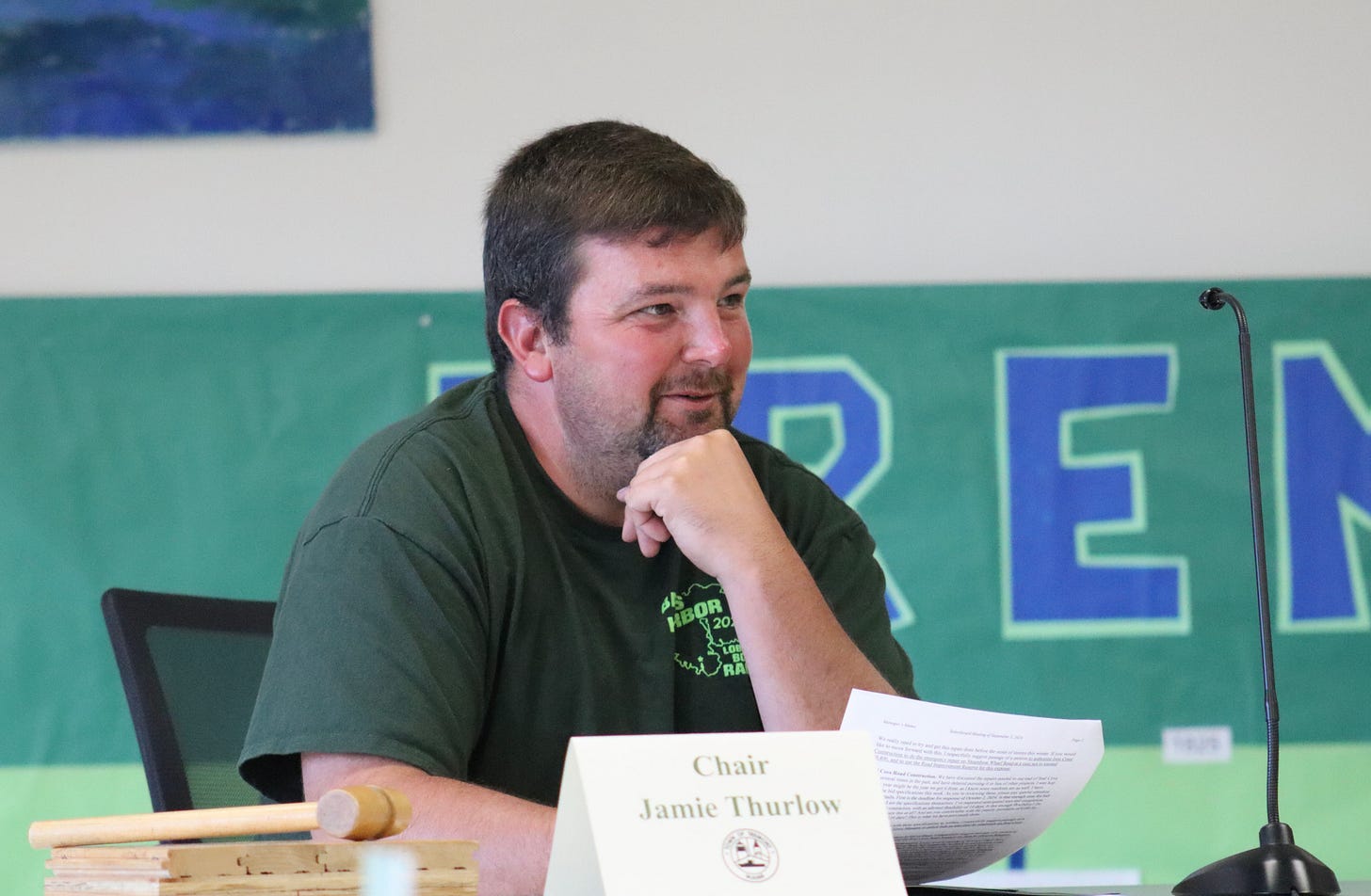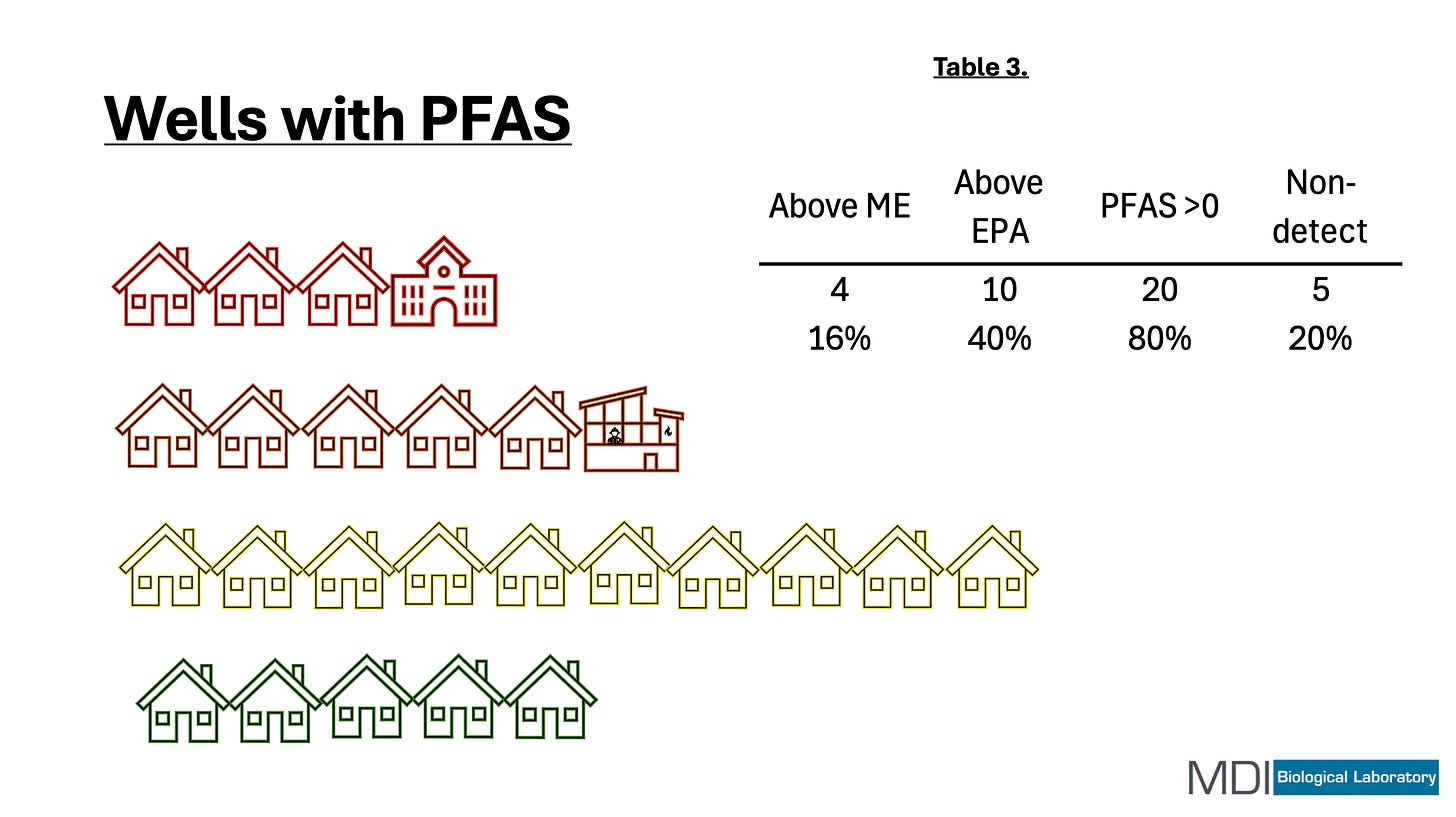You Have to Make Money to Spend Money
Town of Tremont Hears Presentations From Ambulance Service and Banks
TREMONT—At the September 3 meeting of the Tremont Select Board, Southwest Harbor–Tremont Ambulance Service Board President Andy Cline gave an update on the status of the ambulance service and why it will probably be asking for more money for its budget next year.
Cline started off with some good news and told the Select Board that as most of them probably were aware, though the ambulance service’s brand-new ambulance didn’t fit in the building’s bay because it was too tall but that issue has been resolved by the creation of further clearance and the installation of a brand-new door.
“Cost us about $16,000, but it was important to get that done,” Cline said.
Cline then spoke about staffing at the ambulance service and how the organization is fighting the same labor issues as most other employers and volunteer agencies.
The organization has “four levels of licensure, we got drivers, we got basic EMTs, advanced EMTs, and paramedics,” Cline said. “For a number of years, we have been operating with the model of having an EMT or higher licensure on duty at the office in Southwest, where the ambulance is, and a driver on call from home.”
The drivers were initially volunteers and then they started getting paid $2 an hour to be on call. Now it has been bumped up to $5 an hour and the drivers get paid the regular hourly rate if they are called out.
The ambulance service only has sleeping room for one person at the ambulance bay/office and that is the EMT or paramedic. The service has been having problems with driver shortages, especially due to a recent retirement and another retirement coming up. Finding new drivers to fill those positions has been problematic. The ambulance service has tried to get EMTs to fill driver positions but two major issues with that are EMTs not living in close proximity to the station and the low on-call pay rate vs. taking time away from family and personal lives.

Cline said that the service has a number of young EMTs that need to go through on the job training and perform ambulance runs and patient care under the guidance of a paramedic. The ambulance service is finding it very difficult to find the time to do that and have the new EMTs on duty at the same time as the paramedic because of personal living circumstances and because that only one person can sleep at the station.
The ambulance service has come up with a solution to the training issue and for covering shifts and improving patient care. They will now have two EMTs or higher on duty at one time, will provide housing for people if they don’t live in town, and they get paid their full hourly rate.
This, Cline said, will cost more money. The State of Maine limits how much the ambulance service. It can only increase rates a maximum of 5% per year. The ambulance service has received a grant that will be used to finance this program for the next four months, from September through December. The program has already been implemented, Cline said.
There is also another grant opportunity through the state, but the grant application process has not been opened as of yet.
The ambulance service would love to do non-emergency transports as a source of extra money but typically didn’t have the manpower to do those. Under this newly implemented model, Cline said that they should be able to do more transports for local hospitals to generate additional income.
Cline then informed the Select Board that the ambulance service’s budget for next year is going to be in the neighborhood of $100,000 more than this year. According to the ambulance service, the current year of funding was broken down into an almost 60/40 (58/42) split with 58% paid by the Town of Southwest Harbor. The ratio is determined by many factors including population and the number of runs in each town. Assuming this ratio remains the same, Tremont would likely be looking at an additional $40,000-42,000 additional funding for the ambulance service in the next budget cycle if the $100,000 estimate proves to be accurate
Select Board Vice Chair McKenzie Jewett said that she has heard complaints about the service being slow to respond in the community. Jewett then asked what would happen if she called for an ambulance from her home right now. Ambulance service Crew Chief Kristin Hutchins responded that the service is already working under the new staffing model and will respond to the call immediately unless staff members are tied up on other calls and then the service would enlist the aid of Mount Desert, which the town holds a mutual aid agreement with.
Hutchins also said that the previous model of operation was not sustainable. The options for the towns in the near future would be to take the ambulance service over or to contribute more money via the tax base because the ambulance service is out of options for raising additional money on its own.
Cline asked that if the Select Board members receive complaints about the service or response time or if people feel that the ambulance service is not doing its job properly to please pass it on to the organization so that it can address and rectify the concerns. Cline said that people can call the ambulance service or contact a board member via the service’s website.
For the towns to take over the ambulance service as happened in Mount Desert, Cline said, it would be even more difficult a process than it was for Mount Desert because the ambulance service serves two towns.
Hutchins added that even if the towns took it over, they would face the same challenges with finding paramedics, EMTs, and drivers.
According to Atlantic Partners EMS, “Maine EMS, and the nation in general, is experiencing a critical EMS provider shortage that is impacting our ability to respond to emergency calls and provide transfer service for the hospitals.”
A 2023 Maine Monitor Story explains that some states have decreased the minimum age for EMTs and writes, “A federal study projected a need for 40,000 more full-time emergency medical personnel from 2016 to 2030.”
TOWN DEPOSIT ACCOUNTS AND CASH MANAGEMENT
The Select Board heard a joint presentation from two different banks that are vying to be the holder of the town’s liquid assets.
Senior Vice President, Regional Market Manager Lisa Parsons and Assistant Vice President, Branch Relationship Manager Morgan Forni represented Bar Harbor Bank and Trust (BHBT), which has been the town’s bank for more than 32 years.
Senior Business Development Officer Jake Miller and Commercial Loan officer Colleen Maynard represented First National Bank.
First National Bank (The First) approached the town and made Town Manager Jesse Dunbar aware of what the current interest rates on liquid accounts and certificate of deposit (CD) interest rates are that the bank is offering. In turn, Dunbar reached out to BHBT to inquire as to what the bank was giving the town for interest on liquid assets and CDs.
At the time of the solicitation, BHBT was paying the town 1.75% on liquid assets and raised it to 3.75% in August and that rate was locked in and guaranteed for nine months. The First is offering a 4.2% interest rate on liquid assets and also a locked in and guaranteed rate for nine months.
Miller said that over the course of that nine months, the higher interest rate would amount to an additional $10,026 in interest earned for the town. Miller also said that the towns of Bar Harbor, Mount Desert, Southwest Harbor, and Trenton have all been earning 4.2% since August of 2023.
However, BHBT is offering a better interest rate for CDs at 4.75% versus The First’s 4.7%. Both of those figures were for six-month CDs. BHBT gave an interest rate for nine-month CDs but The First did not for this presentation.
Select Board Chair Jaime Thurlow said that he is remiss to mess up such a long-standing working relationship especially with how interest rates and other variables can fluctuate year to year. However, he added, it is the Select Board’s responsibility to be the best stewards of the taxpayers’ money. He said that his preference, because of the long-standing business relationship, would be to ask BHBT to make them more money.
Miller, from The First, said that many municipalities have accounts at both banks and that The First’s offers would stay the same even if the town decided to use both banks to maximize rates across all the different assets.
Parsons, from BHBT, said that the bank’s Senior Vice President in charge of Treasury Sales, Jennifer Seekins was not available to attend this evening’s meeting but would greatly appreciate an opportunity to make a formal presentation to the Select Board.
The Select Board decided that Dunbar would communicate with representatives from both banks and get more solid numbers and rates, including a nine-month CD rate from The First, and put the issue on the agenda for the next meeting so that they can hear a formal presentation.
FOREVER CHEMICALS FOUND IN TREMONT DRINKING WATER
Richard Hilliard, Ph. D, of the MDI Biological Laboratory, gave a presentation to the Select Board on recent PFAS testing that has taken place in Tremont.
Hilliard said that there are six PFAS chemicals currently regulated in Maine drinking water, PFOA, PFHpA, PFNA, PFDA, PFOS, PFHxS, and PFBS and the level of any detectable PFAS chemicals cannot not exceed 20 nanograms/liter, or parts per trillion, in a public drinking water source. One part per trillion would be equivalent to one drop of water in 20 Olympic sized swimming pools.
The United States Environmental Protection Agency explains PFAS as:
“PFAS are widely used, long lasting chemicals, components of which break down very slowly over time.
“Because of their widespread use and their persistence in the environment, many PFAS are found in the blood of people and animals all over the world and are present at low levels in a variety of food products and in the environment.
“PFAS are found in water, air, fish, and soil at locations across the nation and the globe.
“Scientific studies have shown that exposure to some PFAS in the environment may be linked to harmful health effects in humans and animals.
“There are thousands of PFAS chemicals, and they are found in many different consumer, commercial, and industrial products. This makes it challenging to study and assess the potential human health and environmental risks.”
The State of Maine has a statewide mandate to test drinking water at daycare facilities and schools, according to Hilliard, and of the 177 tested, approximately 20% or 37 of them exceeded the state limits.
PFAS have been previously detected at MDI High School and some surrounding homes, at the Tremont landfill and some surrounding homes, and at the Tremont Consolidated School.
Earlier this year, the MDI Bio Lab went to the Tremont Select Board and advocated for the use of some unallocated town ARPA funds to be used for drinking water testing around Tremont. Those funds are available until 2026. A number of residents have taken advantage of the opportunity and had their wells tested. There is funding for approximately 25 more tests according to Dunbar.
Hilliard said that the lab has taken 21 samples and all but eight of those samples have had results returned. Five of the samples were non-residents and the lab, or funding through the lab, paid for those tests. Sixteen of the tests were resident tests which were billable to the Town of Tremont. There were also 12 previous samples tested prior to the bio lab coordinating with the Select Board to use the ARPA funds. That means a total of 25 samples that have been taken and had results returned.
Of those 25 samples, 20 samples had detectable PFAS levels and four of those samples had results that are above the state’s standards, which is for public drinking water only, not private well water. Ten of those samples, including the four that are above the Maine standard are above the Environmental Protection Agency (EPA) standard.
In April 2024, the EPA announced the final National Primary Drinking Water Regulation for six PFAS. This new ruling has much stricter standards than the current Maine regulations and has limits ranging from four to 10 nanograms per liter or parts per trillion. According to the new ruling, public water systems “have three years to complete initial monitoring” and “five years to implement solutions that reduce these PFAS if monitoring shows that drinking water levels exceed” the enforceable levels.
Hilliard also said that many of the samples that were taken in Tremont were done in such a way as to bypass any filtration systems that may have been in place so that they could get a true reading on what chemicals are in the water prior to filtration. Filtration systems can remove or reduce the PFAS from a water source, and according to Hilliard, do not have to be very fancy or expensive to have a PFAS reducing affect.
STEAMBOAT WHARF REPAIR
The Select Board unanimously voted to authorize Dunbar to pay $9,400 to Iron Coast Construction to make emergency repairs to a section of the Steamboat Wharf Road where a utility pole is endangered due to last winter’s storms. The area around the pole needs to be shored up to maintain the integrity of the pole. The money will come from the town’s road improvement reserve fund. FEMA may pay for part of the repair but they are deciding on how much if any because it is not able to be repaired in the typical FEMA style of fixing it as it was originally according to Dunbar.
SEAL COVE ROAD CONSTRUCTION
A culvert needs to be replaced on the Seal Cove Road and a small section of the road needs to be repaved. The Select Board unanimously authorized Dunbar to put the work out for bid.
The next Select Board meeting is scheduled for September 16 at 5:00 p.m.
LINKS TO LEARN MORE ABOUT PFAS ON MDI
If you’d like to donate to help support us, you can, but no pressure! Just click here.
If you’d like to sponsor the Bar Harbor Story, you can! Learn more here.














The 4 communities on Mount Desert Island came together and successfully integrated the island high schools over 50 years ago.
Mount Desert Island High School faculty have successfully educated and integrated MDI’s children island for over 50 years.
This is the model for the future on MDI.
The Town’s of Bar Harbor and Mount Desert Police Departments are currently leading the way.
The scale of these integrations have created opportunities far beyond what 4 smaller communities could possibly offer individually.
It is time to integrate island wide all public emergency services as service expectations, costs, labor and housing escalates beyond what individual town resources can provide.
Police departments, fire departments, public works departments and, as this story keenly illustrates ambulance services are all candidates to incorporate into larger more effective and efficient units.
What are we waiting for?